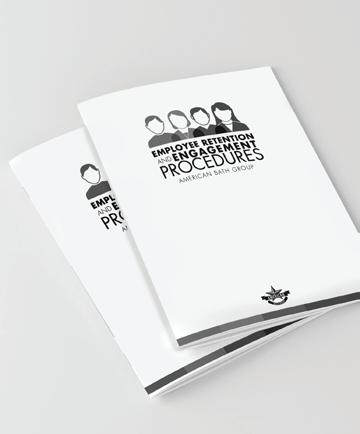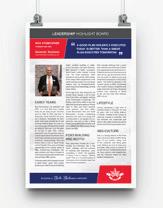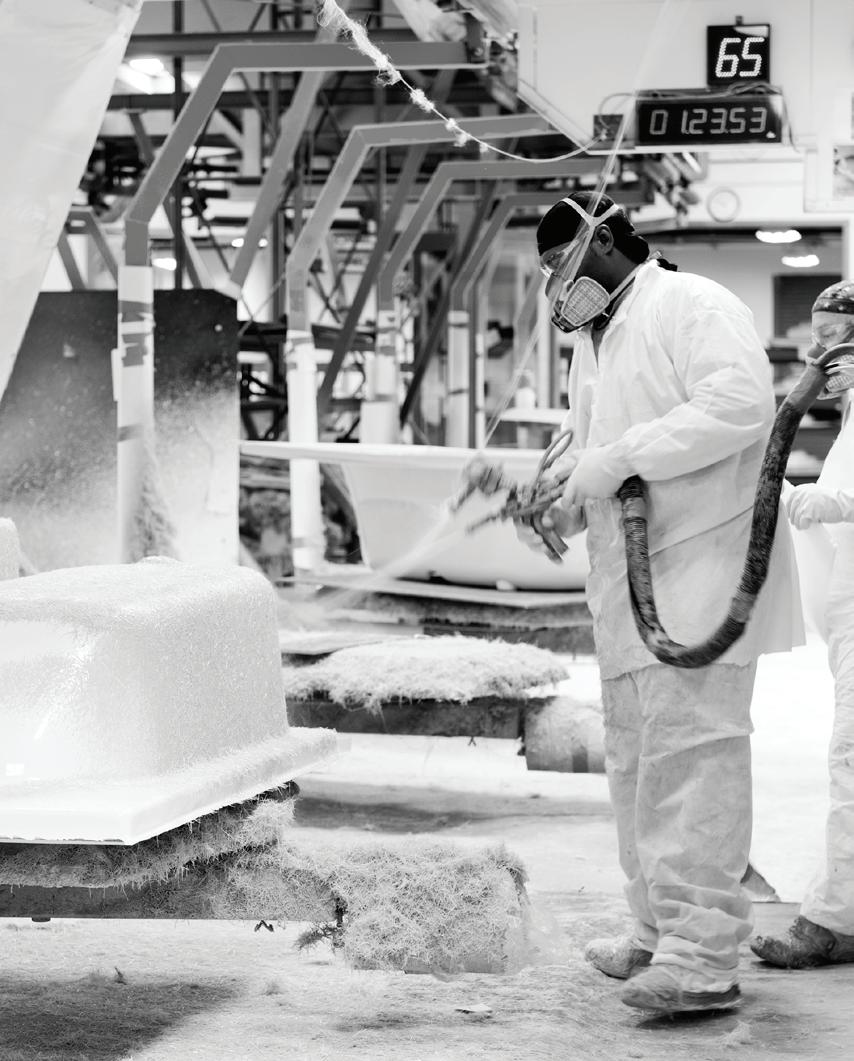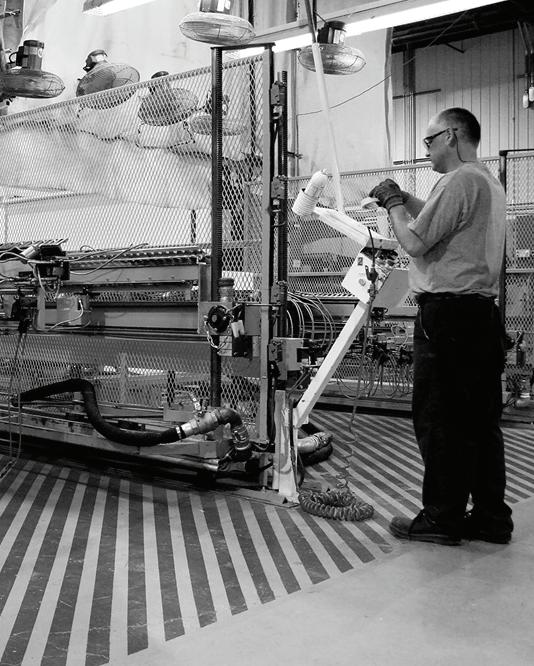

table of Contents
part 1 part 2 part 3
Chapter 1 Introduction to Employee Engagement 4-11
Chapter 2 10 Primary Factors of Employee Engagement . . . . . . . . . . . . . . . . . . . . . . . . . . . . . . . . . . . . . . . . . . . . . . . 12-13
Chapter 3 Factor 1 – Manager Factors 14-19
Chapter 4 Factor 2 – Employer Factors 20-23
Chapter 5 Factor 3 – Empowerment 24-25
Chapter 6 Factor 4 – Expectations . . . . . . . . . . . . . . . . . . . . . . . . . . . . . . . . . . . . . . . . . . . . . . . . . . . . . . . . . . . . . . 26-29
Chapter 7 Factor 5 – Tools, Training, and Resources 30-31
Chapter 8 Factor 6 – Job Fit 32-33
Chapter 9 Factor 7 – Growth and Development . . . . . . . . . . . . . . . . . . . . . . . . . . . . . . . . . . . . . . . . . . . . . . . . . . . . . 34-35
Chapter 10 Factor 8 – Team-Related Factors . . . . . . . . . . . . . . . . . . . . . . . . . . . . . . . . . . . . . . . . . . . . . . . . . . . . . . . . 36-37
Chapter 11 Factor 9 – Interdepartmental Factors 38-39
Chapter 12 Factor 10 – Cultural Factors 40-45
Chapter 13 5 Steps to Create Engagement 46-52
Appendix A 5 Steps to Create Engagement Summary 53
Appendix B
Action Items by Factor Summary 54-61
Appendix C Operation’s EE Best Practices . . . . . . . . . . . . . . . . . . . . . . . . . . . . . . . . . . . . . . . . . . . . . . . . . . . . . . . . . . 62-63

IntroduC tIon to employee engagement
As a company, ABG is focusing on creating excellent Customer Experiences for both our internal and external customers Creating excellent experiences for our internal customers, which are our team members and members from other teams within ABG, is just as important as creating excellent Customer Experiences for our external customers Our internal customers, or our teammates and members of other teams, are responsible for the success of our day-today operations, for creating wins and achieving goals, and ultimately creating the success of us as a company In order for the team that you lead to be successful and contribute to us winning as a company, team members have to execute their job with passion, drive, discipline, and dedication
Team members who do excellent work and are passionate, driven and dedicated to what they do are what we would call “engaged” Engaged team members work harder, stay longer, ask what they can do better, and overall contribute more to the success of the team in comparison to disengaged team members
At the American Bath Group, our desire is to be excellent and we are in the constant pursuit of achieving that excellence In order for us to be excellent, the team you lead and the members that make up that team must be excellent If you, as a leader, have highly engaged team members, you and your team will perform excellently which will greatly contribute to your team winning as well as us winning as a company . If you don’t have engaged team members, then your team won’t perform excellently, and ABG will not achieve excellence
that leads us to our fIrst questIon. What exaCtly Is employee engagement (ee)?

employee engagement defIned
engagement is a state of being of employees that is characterized by the discretionary use of their mental and emotional energy which is exhibited through their on-the-job behaviors These behaviors of engagement result from maximizing the levels of antecedent factors of engagement
In other words, engagement is when employees show more interest, passion, drive, and give extra on the job because factors in our workplace that increase employee engagement, such as team members getting positive feedback from their manager or being publicly celebrated for their excellent work, are being used effectively by the leaders in our organization

busIness ImpaC t
Is employee engagement a bIg deal?

It absolutely Is.
So, what is the impact of Employee Engagement? Well, Employee Engagement is central to our success as a company . Employees who are engaged are easier to work with, show passion in their job, are motivated, strive for more, handle stress better, interact better with other team members, and perform better overall . Unfortunately, 87% of all employees across industries are not engaged in their work Yet, companies with highly engaged employees outperform competitors by 147% (Gallup, 2017) These numbers demonstrate that the business impact of having engaged employees is enormous However, if 87% of employees across all industries are not engaged, then American Bath Group’s employee base is likely similar in levels of engagement This means that as leaders, continued pursuit of engaging your teams is a core responsibility of your leadership position .
responsIbIlIty
Given the impact engagement creates, it is essential that we, as leaders, focus our efforts on creating engaged employees . As leaders, it is your core responsibility to ensure that your team members are engaged If they are not, it is your responsibility to understand why they aren’t and create positive change . In your role, you take on a responsibility for the successes and the failures of your team A substantial part of the success of your team is dependent on how engaged your team members are . If you’re turnover rate and absenteeism is high, and engagement scores low, it is your responsibility to figure out what is going wrong and implement ways to engage your team Engagement is a leadership responsibility .
so hoW do We do engage our team members?
fIrst, thInk about thIs.
You have been to or at least seen popular restaurants The line is long, and the wait is much longer than you would experience at other places . In the end, people just want food…right? Not exactly . People want food, but they also want much more They want a nice setting They want good choices They want excellent service They want to be part of something that is considered a good thing . They want to be paid attention to They want the right lighting They want high quality food that satisfies They want a clean and inviting environment that makes them feel comfortable and welcomed They want reasonable prices They want their order to be right And, they want their order in a timely manner so they can get on with their day
Employee Engagement is much like this It is about creating a setting where so many of the things that are important to people exists . It is about creating a setting where (1) a person feels they make a difference – their work and effort matters It is about (2) feeling fair treatment exists It is about (3) feeling pride in the work product that is being created . It is about (4) getting recognition for a job well done It is about (5) being part of a team It is about (6) seeing areas of opportunity for oneself if the desire exists It is about (7) personal growth . It is about (8) knowing that when things don’t go right, coaching and encouragement will occur It is about (9) being involved, (10) helping solve problems, and (11) having your opinion asked .
For a leader to be strong at engaging their employees, they have to be trained to recognize and understand the importance of the previously listed items . They also have to be trained to understand how their role creates and largely influences the existence of these items within their area and ultimately, within the company . Generally, for the American Bath Group, the focus is around showing leaders how to care and demonstrating their care to the people they lead and work with .
shoWIng you Care
At the American Bath Group, showing that you care is something we refer to as stickies Stickies create an emotional bond or emotional “stickiness” between a leader and their team members . Stickies are created when we show a genuine interest in and genuine care for our people Stickies can be created through having non-workrelated conversations where you, as a leader, ask your team members how things are going outside of work, how their families are, or how their sick relative is recovering Stickies can be created when you coach and mentor your team members because this shows a genuine interest, care, and investment in your people Stickies can be created by walking the floor, smiling, talking to your employees, asking questions, having discussions, celebrating wins, etc . Stickies can be created between you and your team members any time you show genuine interest and care in them, regardless of the method . So, get creative and be genuine about it .
When your team members can see through your words and actions that you have a genuine interest in them and care for them, they will give you extra on-the-job effort and go above and beyond for you when needed Employees that feel a strong connection with their leaders are more engaged in their work, so they do higher quality work at a more efficient pace
In order to gain the hearts of our people and engage them, we must show we care, and we must put extensive effort into the demonstrating this care to all of those we work with every day .

ee starts from the begInnIng
Engaging your team is an on-going process that starts from Day 1 on an employee’s journey with us at the American Bath Group When an employee first arrives at ABG they will be both excited and uncertain of what to expect . Uncertainty in our new team members can either be turned into a negative experience that causes anxiety and disengagement, or it can be turned into a positive experience that starts to form engagement within our new team members
So, as leaders, how can we take our new team members and quickly get them comfortable with both their job, the people they work with, and you as their leader so that their level of engagement will increase from the start?
We can do this by:
• Making positive first impressions by smiling and asking the new team members how their day is going .

• Giving new-hires a tour of the facility and familiarizing them with their surroundings on Day 1 .
• Clearly defining and explaining the job, role, expectations, responsibilities, and providing clear and effective training to our new-hires .
• Making regular follow-ups throughout the first day and through the first few weeks with your new team members to ensure that they are comfortable and have the tools and resources they need Regular follow-ups with new team members should occur 3-4 times per day within the first couple of weeks This will ensure that team members are comfortable, confident, and have what they need to be successful
• Begin “stickies” with new team members from Day 1 . Ask new team members a little bit about themselves and get to know them so they feel comfortable and begin making connections with other team members at work
• Compliment new team members often on their progress Celebrate the small wins frequently during the first few weeks
• Take new team members out to lunch
• Introduce new team members to each person on their team and assign a buddy for the first few weeks . Hold the new-hire buddy accountable for sticking with the new-hire
• Introduce new team members to all leaders .
• Hold a team lunch within the first couple of weeks
• Discuss who ABG is as a company to form an emotional bond and show new team members the values and vision of the awesome company we work for (ABG mission, vision, Core Drivers, Origins Story, Leadership Highlight stories, ABG Core Cultural Values) .
For more suggestions and methods of on-boarding employees and increasing engagement during the on-boarding process, please refer to our Employee Engagement Handbook and our On-Boarding Training Video

faC tors of employee engagement

Now that we have discussed the most important part of Employee Engagement – showing that you genuinely care for and have a genuine interest in your team members, as well as the fact that employee engagement starts from Day 1 and that it is extremely important to engage our team members during this time because this critical time period is where they will decide to either buy-in to and engage in working at ABG or they will disengage and likely quit –let’s now discuss other ways to create positive change in engagement levels within our teams . But before we do that, let makes sure that we have a clear understanding of what Employee Engagement is and how to best think about it
hoW to best understand employee engagement
Employee engagement, like any other idea used to help us understand why things are a certain way in human behavior, can be best understood by the factors that affect engagement levels, also known as antecedent factors .
What does this mean? It means that certain actions and events that happen in the workplace, such as team members receiving positive feedback from you, their leader, or being publicly recognized for their excellent work, help to either increase or decrease engagement levels within our teams . So, if we understand what actions and events, or factors, affect engagement levels, then we can make sure that we are positively influencing each of those factors and ensuring higher levels of engagement with our teams
If it’s still unclear, think of it this way . In our operating facilities, if a problem occurs, we may have a Kaizen event or a problem-solving meeting to determine the causes of the issue Let’s say we use a fish-bone diagram to help us solve the problem . On our fish-bone diagram we would list out all the potential causes of the problem to then determine the root cause So, if we know that shift changes, poor training, and poor processes creating excess waste are causing the issue seen in the plant, then we can work our way towards a solution
In the same light, if we want to understand how we can best create the setting for our team members that will engage them, we must first define the factors that affect engagement levels within our team members (the causes on our fish-bone diagram), so that we can then form a clear picture of what it takes to create engagement within our teams, as well as to help solve engagement problems when engagement is low .
This leads us to our discussion of what factors affect employee engagement levels .
There are 10 Primary Factors that affect Employee Engagement levels We will address each of these 10 factors as well as give suggestions for you, as leaders, on how you can positively influence each of these factors and ultimately increase engagement levels within your teams


faCtor 1: manager faC tors
Factors of Employee Engagement that a team’s leader has a significant effect on include: having open communication between yourself and your team members, supporting and having the backs of your team, motivating and inspiring team members to achieve more, truly caring about and showing your genuine care and interest in your team members, giving clear feedback and direction to team members, recognizing your team and its members for doing good work, and taking the time to coach and mentor .
Additionally, factors that are listed elsewhere on a tenfactor list that are directly impacted by a team’s leader include putting the right employees in the right positions, empowering employees, setting clear expectations, providing the tools, training, and resources to do the job effectively, and forming strong growth and development plans for each team member and holding them accountable for reaching those goals

foundatIon
As previously stated, the foundation to engaging your employees is to truly care about them That means searching deep within your core value system and determining whether those values are aligned with truly caring about your employees Secondly, forming trusting relationships with your team members is a foundational element of Employee Engagement Trust is formed primarily from three sources including: building positive relationships with your teams, exhibiting good judgement and expertise as a leader, and consistency – walking the walk and being dependable (Zenger & Folkman, 2019) Additionally, showing humility by asking for help from others when you need it, and asking for team members’ input when appropriate tremendously impacts trust between a manager and their team . As always, stickies are a huge piece of the puzzle when it comes to showing you truly care and are invested in your team members
responsIbIlIty
Given the impact engagement creates, it is essential that we, as leaders, focus our efforts on creating engaged employees As leaders, it is your core responsibility to ensure that your team members are engaged . If they are not, it is your responsibility to understand why they aren’t and create positive change

stICkIes
After you have your foundation (i e core value system and trust relationships) set, demonstrating that you truly care about employees is the first step in creating engaged employees . At ABG, creating stickies (i e demonstrating your care and interest) is a highly common practice that has seen success in our Employee Engagement program . Creating stickies and showing that you care can be done in many ways Having conversations that are non-work related where you get to know your employees on a personal level is an essential part of showing you care Walking the floor and smiling, talking to your employees, “first bumping”, sharing wins, saying thank you, discussing ideas, asking questions – these actions create stickies . Additionally, celebrating birthdays, anniversaries, throwing baby showers, bringing in food on Fridays for your team members, taking time to coach and mentor – all of these actions substantially increase stickies and ultimately engagement levels within your team members
leadershIp CommItment
As with anything in life that is worthwhile, Employee Engagement is not a destination that once we arrive, we can call it a job well done and move on . Engaging your team is a daily discipline that you, as a leader, must dedicate yourself to Engaging your team is a constant pursuit of a successful leader Having a team full of engaged members is something that you have to earn daily . Commit yourself to the daily discipline of engaging your team members and you will have engaged teams
ne W-hIres and on-boardIng

During this time in an employee’s tenure, frequent communication and follow-up is essential in creating engagement . Communication and follow-up should occur every day the first two weeks of on-boarding, and multiple times per week for the proceeding months For more information on maximizing engagement efforts during new-hire on-boarding, please refer to the EE Starts from the Beginning section of this document, our Employee Engagement Handbook, as well as our On-Boarding Training Video .
performanCe feedbaCk
When learning a new skill, employees need frequent communication and feedback to reinforce what they are doing (instilling confidence and efficacy) as well as coaching and mentoring When employees have been using a skill for quite some time, the frequency in feedback can be less frequent but still present . Remember our general rule of thumb for positive reinforcement and compliments at ABG Use the 4 to 1 principle where you give 4 compliments to a team member for every criticism
CoaChIng and mentorIng
Coaching and mentoring your team members is vital to Employee Engagement When you take the time to show team members what they are doing well, what they can improve on, where you see them going within the team and company, teaching them new skills and helping them refine old skills, giving them larger responsibilities, and helping them develop in their position through coaching and mentoring, you demonstrate a true care and interest in the employee Not only does this provide a benefit for you and the team as the employee’s performance will improve, but engagement levels within the employee will also significantly improve because he or she will feel cared for and invested in .
Create prIde
Creating pride within our teams comes from showing them how they are winning as a team, how we are winning as a company, and how the fruits of their labor are making a difference Another aspect to creating pride within your team is accomplished by always speaking highly of our company, our products, our culture, our values, and the people that work within ABG . You set the tone as a leader . If you speak (1) highly of our company, our products, our culture, our values, and the people that work within ABG, (2) show team members how they are winning as a team and as individuals, how we are winning as a company, and (3) how the fruits of their labor are making a difference in our community and within the bathtub industry, you will lead a proud and engaged team
Additionally, (4) small but meaningful acts such as giving ABG gear (i e hats, t-shirts, polos, sweatshirts, coffee mugs) go a long way to creating pride within your teams

WInnIng
Our team members want to know that they are a part of a winning team Keeping track of performance in the form of KPIs, Hour by Hour boards, performance reviews, among other methods of tracking performance are essential to showing our team members how they are doing individually and as a team in terms of achieving goals and creating success Additionally, showing employees how we, as a company, are winning in the marketplace shows them that they work for a winning company We, as leaders, want to win and so do our team members Make sure that you are showing them how they are winning as individuals, as teams, and how ABG is winning as a company
reC ognItIon
Recognizing team members both publicly and privately for outstanding performance is something that greatly increases engagement levels in employees . Look for opportunities to celebrate wins within each of your team members by (1) helping them set performance goals and celebrate when they reach them, by (2) actively seeking out opportunities to celebrate when a team member goes above and beyond their job duties, or by (3) setting up rewards programs Additionally, (4) celebrating team members’ birthdays, anniversaries, among other milestones and successes are excellent ways to publicly recognize team members and increase engagement levels For specific suggestions and examples of team and individual recognition, please refer to our Employee Engagement Handbook

Leaders can engage their team by:
Demonstrating true care for your employee
Taking responsibility, as a leader, for engagement
Stickies
Leadership commitment and daily discipline
Coaching and Mentoring
faC tor 1 summary
so, as a leader, hoW Can you ensure that you are engagIng your teams?
Showing how our company, teams, and team members are winning
Showing teams and team members the fruits of their labor (i e how their work makes a difference)
Practicing open communication with team members
Providing strong support to team members
Motivating and inspiring team members
Giving consistent and clear feedback and direction
Giving recognition to employees both publicly and privately
Forming strong, trusting relationships with your team and team members
Putting the right employees in the right positions
Empowering employees
Setting clear expectations
Giving the tools, training, and resources to team members that are necessary to do their job
Establishing strong growth and development plans and holding team members accountable for reaching new goals (both behaviorally and tactically)
Creating Pride
faCtor 2: employer faC tors
Factors that ABG leaders and our division leaders have an effect on in regard to engagement include: working for an employer that cares about employees as a person and shows it, organization-wide and division-level recognition, as well as organizational justice – or, a system where employees feel they are being held to the same standards in a company and policies being enforced fairly among all When employees and teams do not feel that the company and its leaders know they exist, or they feel that they work hard but are never recognized by their company leaders for doing so, employee engagement levels have been shown to decrease . Additionally, if rules and policies are not enforced equally to all employees, employees perceive a sense of injustice in the organization (e g favoritism) This has also shown to lead to decreased engagement levels This is why, as a leader to your team, you must enforce rules and policies equally to all employees Avoid showing favoritism as it will decrease other team members’ levels of engagement and negatively impact the team as a whole .

leadershIp ConneC tIon
Employees need to feel some sort of a connection with their top leaders in the organization Employees frequently do not know their top leaders in the organization, and often they form conclusions about their leaders without any real existing knowledge of them . In the absence of personal contact, the human element, comes rumination and negative images we form about others; leaders in a company are of no exception How can we increase leadership visibility and personal contact with employees? While our leaders are not omnipresent, their presence can be increased with Leadership Highlight boards that display a personal element, as opposed to a traditional rigid corporate highlight story Additionally, videos can be made from top leaders discussing the mission, vision, and cultural values of the company, as well as personal things about themselves (if they wish) . These efforts go a long way in engaging our teams
Culture
In addition, continuous discussion from you as a leader to your team members about the ABG Culture, Mission, and Vision are crucial for team members to feel a connectedness with ABG and to be engaged in the company Without this discussion of what separates ABG from other companies (i .e . our unique culture, mission, and vision), employees feel that they are working for just another company .
leadershIp presenCe

Additionally, as a leader to your team, whether you are a department manager, plant manager, supervisor, team lead, or another leadership position, (1) simply getting out of your office and walking the floor a few times per day, (2) asking team members how they are doing and if they need anything, (3) among other genuine interactions will increase your overall leadership presence and employee engagement levels . So, get out, walk the floor, speak with your people regularly, form strong relationships, be the type of leader that team members feel comfortable talking to and enjoy working for .
reC ognItIon
At the organizational level, taking the time to recognize teams and specific team members for their dedication, passion, discipline, and mastery has an incredible effect on Employee Engagement levels . As previously stated, employees want to work for a company where they feel they make a difference; that they aren’t just another cog in the machine Team members want to know that our leaders care about them and know who they are When we recognize our teams and team members for their excellence, we show our teams across the organization that we care for them, that we recognize their excellent work and efforts, and that they matter
Internal communications such as I AM CX and the ABG Way, where we recognize teams and team members for Taking Care of Each Other, Taking Care of the Customer, and Doing Good Work, are geared towards ensuring that we, as an organization, take the time to recognize our employees for their dedication, passion, discipline, and excellence

faC tor 2 summary
We can engage our teams by:
We can engage our teams by:
dIvIsIon level
Division leaders giving recognition to teams and individuals for their excellent work
organIzatIonal level
Company-wide recognition (i.e. ABG Way Highlight stories – formerly known as I AM CX)
Equal enforcement of rules and policies among all employees at the organizational level
Leadership connection at the organizational level
Leadership highlight boards
Leadership Videos
Common culture connecting us all
Frequent internal communications regarding ABG culture, core drivers, mission, and vision to unite us all under a common purpose and expectation
Team leaders giving recognition to teams and individuals for their excellent work
Equal enforcement of rules and policies among all employees at the division level
Equal enforcement of rules and policies among all employees at the team level
Leadership connection at the division level (i e daily walk the floor, stickies, etc )
Leadership connection at the team level (i e stickies, walk the floor, etc )
Common culture connecting us all (division leaders and team leaders)
Frequent discussion about our culture, mission, and vision – bringing us all together under a common purpose and common expectation .
so as employers, hoW Can We ensure that We are engagIng our teams? lookIng at It from both the organIzatIonal level (Company-WIde) and dIvIsIon/team level...
faCtor 3: empoWerment
Empowerment plays a significant role in the level of engagement of employees Actions such as (1) taking ideas for innovation from your team members seriously and implementing them if possible or coaching if not feasible is a part of empowerment (2) Giving team members the ability to make self-directed decisions within reason is another part of empowerment Additionally, as a team leader, (3) listening to and considering input for change and innovation from your team members is a part of empowerment .

When employees have the ability to make autonomous decisions, are able to provide input for improving processes, and are asked what input they have before certain decisions are made, Employee Engagement levels have been shown to increase
Empowerment can be increased within your team by (4) asking them for feedback before a change takes place, (5) asking them for feedback after a change takes place, (6) utilizing suggestion boxes, (7) forming innovation groups within your teams such as our CI team members who meet regularly to discuss continuous improvement and innovation, (8) asking your team for input regularly regarding how things can be done better or how our processes can be improved, (9) teaching your team members to see waste and opportunities for continuous improvement, (10) or anything else that you can get creative with the try to draw ideas for innovation from your teams
faC tor 3 summary
We Can engage our teams through empoWerment by:
Giving employees the ability to make autonomous decisions
Asking input from employees before implementing changes (when appropriate)
Using suggestion boxes
Forming innovation groups within your team
Asking for feedback before and after changes
Teaching team members to see waste and CI opportunities
Asking for regular team input
Creativity – Anything else that you feel would empower your team Get creative
faCtor 4:
e xpeC tatIons
Having clear expectations at work where team members clearly know what is expected of them is a major part of Employee Engagement Additionally, team members need to know who they can go to if they need help This means that clarity in terms of roles and responsibilities, as well as who team members can reach out to for help is vital when ensuring that our teams are engaged .
settIng and managIng e xpeC tatIons
Setting and managing expectations involves the proper use of (1) job descriptions, (2) role defining, (3) setting and managing performance baselines with all employees and (4) setting specified goals to get them to the next level of performance, (5) giving consistent performance feedback, etc
This includes:
• Hour by Hour boards and daily informal performance management
• KPI measurements you use to track your team’s and team member’s progress
• More formalized performance management activities such as employee performance reviews
Each of these are essential in engaging our teams Without clarity in terms of performance, our team members will not truly know how they are performing or if they are winning as individuals and as a team Ultimately, if teams and team members do not feel that they are winning, they will not be engaged . This is where coaching and mentoring is vital .
When employees do not know:
• What they are responsible for
• How to execute the things that they are responsible for
• How they can improve their performance engagement levels will suffer
performanCe feedbaCk
Additionally, clarity in expectations means that each team must practice continuous feedback and honesty with one another The worst thing you can do as a leader is cast truthfulness and tough love aside in the hopes of forming a “safe” environment People, yourself included, cannot grow if they are not challenged It is your job to challenge yourself and others through open feedback and tough love
open feedbaCk and tough love
Get comfortable with open feedback and tough love Challenging others to live up to and exceed expectations is essential in winning and engaging our employees . This means as a leader you have to take action to invite regular feedback and give regular feedback Taking action to receive and give regular feedback between yourself and your team members means:
• Creating open-door policies
• Allowing for thoughtful discussion and disagreement in meetings without getting emotional

• Asking for feedback on your thought-processes and where you stand as a leader regularly
• Being honest with your team members about their performance and showing them how they can improve
• Creating a culture where truthfulness and transparency are valued, even if that means showing tough love (i .e . getting negative but truthful feedback) .
faC tor 4
faC tor 4 summary
We can engage our team members by clearly defining and managing expectations through:
Job descriptions
Role defining (task inventories and responsibilities)
Performance baselines and continuous measurements
Goal-setting
Performance feedback
Open communication and tough love
Coaching and mentoring
Performance reviews
Challenging team members through increasingly difficult goals (i .e . specific goals)
Clearly defining for team members who they should go to for help
Giving honest, real feedback. This may mean tough love, which as a leader you will have to get comfortable with .
Taking action to invite and give regular feedback.

faCtor 5:
tools, traInIng, and resourCes
Employees need to be given clear expectations, tasks, and goals for them to accomplish . However, it is necessary to give employees the tools, training, and resources they need to accomplish the tasks and goals you put before them This has a strong impact on levels of engagement .
Giving employees the proper tools, training, and resources can be accomplished through practices such as:

• Standard Visual Work instructions
• Checking in regularly with new-hires to ensure they have what they need to be successful (3-4 times per day in the first few weeks)
• Making comprehensive lists of the tools, training, and resources required for a position and ensuring that each are executed during on-boarding and throughout a team member’s tenure
• Ensuring that each position that you are responsible for leading has strong training programs that are laid out clearly and comprehensively, and that team members are trained on each aspect of the training program
• Holding responsible parties accountable for executing their portion of the training program
• Tracking training program progress and ensuring that trainees are completing each phase of the program .
• Ensuring training program effectiveness and revamping ineffective training programs
• Ensuring that your team’s tools are working properly
• Asking team member’s feedback on training program effectiveness and gathering input on any tools or resources they may need to be successful
• Anything else you can think of that would improve the quality of tools, training, and resources your team members need to be successful
Your team members need the tools and resources that enable them to do their job effectively If employees are given tools and resources that make the job more difficult, they will likely question the utility of such tools and why you won’t invest in tools that will actually help them . When tools and resources are sparse or inadequate, engagement levels will suffer
faC tor 5 summary
We can engage our team members by:
Executing the 10 items on the previous page
Revamping training programs and holding parties accountable
Frequent check-ins with new-hires or existing team members who are learning a new skill
Feedback from team members regarding training program effectiveness and other resources they may need
Investing in tools that enhance the job as opposed to hindering performance
Ensuring resources are in place to maximize performance
faCtor 6: Job fIt
You would be hard pressed to find employees who are engaged in positions they do not like Place employees in positions that suit their strengths and that they enjoy, and engagement levels will rise
Asking employees what interests them and what their goals are can help you determine what the best fit is for the employee Additionally, hiring for personality over skills is a practice done by most successful managers, as knowledge and skills can be taught, but personality is more enduring . If an employee is struggling in one position yet exhibits the knowledge and skills to excel is another position, place them in the more suitable position .
A word of caution – Do not be confused between employees who are not a good fit for the company (those whose values and personality do not fit with the demands), and those that are not a good fit for the job they are currently in The former can become a cancer for the team they are on, while the latter are simply in the wrong position .

faC tor 6 summary
We can engage our team members by:
Ensuring job fit through the following actions:
Ensuring that candidates fully understand the job and its responsibilities before accepting the position
Fully discussing ABG and its principles to ensure that the candidate is a fit for the organization
Ensuring that a job candidate meets the knowledge, skills, abilities, and personality required for the job before hiring them .
Easing new employees into the position over the first couple of weeks so that they can get a feel for the position and ensure that it is a good fit before both parties invests more time and energy
Speaking with team members regularly about how they are doing in their position If they strongly dislike the position, find another position that is more suitable if possible . If they are happy with the position but strongly desire to take on more responsibility, give it to them .
If a team member wants to take on more responsibility or learn new skills (e g cross-training), help them do so
faCtor 7:
groW th and development
This is one of the most impactful factors of Employee Engagement . Most employees want to work for a company that they see a future with . Employees want and need to be given a set of tasks and responsibilities with stretch goals that are based on performance measurements to progress who they are as a professional, and who they are as a person Additionally, employees need to see a clear line of vision for being able to progress (sometimes laterally as hierarchical increases are limited) to the next level in their job
Growth and development does not mean that we end up with too many chiefs and not enough Indians . Growth and development means that (1) managers get on the same page as their employees with what their aspirations are in their position and with our company, as well as (2) defining where the employee is in his or her current performance, (3) making explicit goals for the employee to hit in order to improve their performance in their current position, as well as (4) providing hierarchical or lateral visibility into a progressive future with the company

faC tor 7 summary
Action Items:
As leaders, you must get on the same page as your team members by having frequent conversations with them about what their aspirations are Some team members simply want to come in to work, complete their hours and go home Others want to grow and take on increasing responsibilities and learn the skills that comes with it Get on the same page as them and make a plan to get them to their next level of performance
Establish clear baselines of performance for your team members and establish growth and development plans that, if followed, will take your team members to the next level of their performance
Follow up on your team members progress within the growth and development plan regularly to ensure that they are being held accountable .
Talk to your team members about their future in the company, where you see them going, and what opportunities there are for growth into higher positions .
Cross-training: See below
Action Items Continued:
Managers and team members aligned on growth and development aspirations
Performance
management
Baseline performance measures tied specifically to a position’s responsibilities and tasks
Growth and development plans with specified goals and timelines to get team members to the next level of performance
Regular follow-up Hierarchical and lateral paths of advancement in a company for all positions
Acceptance into these new positions based on performance
Cross-training: Cross-training employees is a practice that has been success across ABG . This helps expand our team members skills sets and the value they provide, keeps efficiency up, decrease boredom and complacency on the job, and shows our team members we care for them and that we are willing to invest in them
Cross-training can have a great impact on employee engagement . There are significant benefits to cross-training our team members, but in terms of engagement, cross-training significantly increases team members engagement levels because it keeps the job interesting, increases their skill-sets, decreases boredom, and shows our team members that we care about them and are willing to invest in them . Additionally, cross-training helps our team members build the skills that will allow them to grow both laterally and hierarchically within the company
hoW Can We ensure that our employees feel that they have room to groW and develop at abg?
8:
team-related faC tors
Teams that communicate well with one another, help each other solve problems, and support each other foster more engaged individuals .
From the time that a new-hire is on-boarded, ensuring that organic opportunities for positive relationship formation frequently present themselves is very impactful in terms of engagement (e g assigning buddies for the first couple weeks of on-boarding, consistent follow-up with new-hire by management, new-hire lunches, lunch with leaders, etc ) Additionally, managers setting clear expectations for their teams regarding how they are to interact with one another plays a role here (i .e . what is acceptable and what is not – rules of engagement) Hiring for personality also comes into play If managers hire incompatible personalities as an addition to a team, the team dynamics will suffer .
posItIve reInforCement
Managers need to ensure that behavior of employees that represents coaching and mentoring, giving a helping hand, etc are recognized and rewarded both publicly and privately to any employee demonstrating this behavior . Along with setting rules of expectations (generally rules of what not to do), it is equally as important for managers to define and reward what successful team member behavior looks like . This can be generalized as (1) being a solid team member (2) lending a helping hand (3) coaching and mentoring other team members (4) taking on team members’ workload when they are our sick or simply too bogged down to get to it (5) or anything else that represents being a good team member
REMEMBER: Define and reward the behaviors that you want your team members to exude, and you will have a team
works better together and, as an end result, are more engaged

faC tor 8 summary
Rules of Engagement: Set clear expectations with each of your team members regarding how they are to engage with one another – what is acceptable and what is not – as well as discuss the importance of having good relationships with each other
Drama and Chaos: Manage problems between team members as soon as they start . Have tough conversations and resolve the issue between team members before it gets any bigger . As our drama and chaos video discusses, do not tolerate drama between team members
Positive Reinforcement: Reinforce positive team members behaviors and define what being a good team member is for your team .
Placement: Place team members with complimentary personalities together – those that naturally get along well . Separate those that do not
Team Huddles: Hold daily team huddle meetings where you celebrate wins, discuss daily objectives, give team member encouragement, and anything else you feel you should talk about to build relationships or increase performance
Food: Bring in food for your team from time to time and enjoy the food together as a team
Celebrate: Celebrate birthdays, anniversaries, wins, and other milestones together as a team
Stickies: Encourage stickies among your team members. It is not only important that you have conversations with and demonstrate to your team members that you care and have a genuine interest in them It is also vital that team members do the same with one another . Have conversations with your team about the importance of stickies and encourage stickies in your daily huddles .
Genuine Relationships: Organic relationship formation opportunities .
On-Boarding Practices: Practices such as assigning buddies, consistent follow-up, new-hire lunches, etc
Hiring Practices: Hiring for personality.
hoW Can We ensure that our team members form and maIntaIn good relatIonshIps WIth one another?
faCtor 9:
Interdepartmental faC tors
Teams in different departments that communicate well with one another and help each other solve problems foster more engaged team members .
Cross-functional team members rely on one another to get answers and solve problems in organizations . Fostering positive relationships with a human element (e g picking up the phone and calling instead of emailing when feasible) between cross-functional team members is one key element in establishing effective interdepartmental communication and collaboration Additionally, setting clear expectations for both parties on what is expected in terms of communication and collaboration, and holding them accountable is vital .
When two or more departments rely on each other for getting answers and solving problems, issues are bound to happen as goals between departments are intrinsically varied (e g sales and warranty) Setting up definitive processes for getting answers and solving problems is essential to proper interdepartmental coordination .
How we can ensure smooth interactions between departments:

• Human Element: Pick up the phone when possible instead of emailing This puts the human element back into the interaction and reduces the chance of misinterpretation and conflict
• Rules of Engagement: Set clear expectations for team members regarding how they are expected to interact with other departments (i e rules of engagement)
• Processes: As the leader of your team, set up definitive processes between yourself and other departments for getting answers and solving problems so that expectations are crystal clear . Hold your team accountable for these expectations and have regular conversations with leaders from other teams regarding how well these processes are working
• Understanding: Seek first to understand, then to be understood As true as the maxim is, it is always best to assume the best in someone else’s intentions
• Common Ground: Always seek to get on the same page as members from other departments and expect the same from your team members
• Set the Tone: As your team’s leader, never speak poorly of any other department or any person from another department You set the tone for the team so if you speak positively of others, your team will follow .
• Speak Kindly: Always talk about and treat other teams the way you want your team to be talked about and treated . Do not throw team members from other departments under the bus in email, on the phone, or through any other communications medium to the customer or the anyone else in the company
faC tor 9 summary
Human Element
Rules of Engagement Processes Understanding Common Ground Set the Tone Speak Kindly
faCtor 10: Cultural faC tors
Having a strong common culture in an organization is a key element in Employee Engagement Employees want to feel like they are a part of something that is impactful, something that is greater than themselves . Your team wants to feel a connection with their work and the people they work with .
Luckily, we are part of a meaningful company that makes a difference At the American Bath Group, we are all a part of something bigger and more impactful than ever before . Our work makes a difference . We are making a positive impact, both within the bathtub industry and in people’s lives The work that we do and the impact we create stems not just from what we do, but how we do it

our Culture
American Bath Group has accomplished what no other entity in the bathtub industry has been able to do; take a host of separate companies and successfully roll them together under one roof while maintaining a multi-brand strategy alongside a decentralized business model Our culture, the collection of our beliefs, values, ideas, and attitudes, is the organizational glue binding us together Without this glue, we, as an organization, will fall apart
Organizations, in order to operate successfully past the size of 150 individuals, need strong cultures consisting of a shared set of beliefs, such as a mission and vision, as well as values, to operate successfully and effectively together in large groups These shared set of beliefs, attitudes, and values form the cultural bond of an organization and its members .
At the American Bath Group, we have already formed and continue to form and reinforce our strong and growing shared beliefs, ideas, mission, vision, and values We are Building a Better Bathware industry, Making a Positive Impact on People’s lives, Focusing on the Experience, Driving Innovation, Pursuing Operational Excellence, as well living the ABG Way – Taking Care of Each other, Taking Care of the Customer, and Doing Good Work
As we continue on our journey together, continuing to form and reinforce our common culture is paramount toward long-term success at ABG . The onus is on our leadership teams at all levels in the organization
As we continue to grow and evolve together on our journey toward becoming industry leaders, we must look to our leaders to continue to grow and support our organization’s cultural values Leaders are the most important entities that guide a team down the path toward success . If we are to continue to win as an organization, our leaders at every level, from the executive, director, and team manager level, must contribute to the reinforcement of ABG’s organizational culture throughout their teams . Without this leadership commitment and subsequent guidance of their team, ABG will fail as a result of lacking commitment from its leaders
At the American Bath Group, our culture, our way of doing things, is what makes us who we are and drives how we accomplish what we accomplish together . Our teams want to feel that they are a part of our culture, the ABG Way, and that they make an impact within the ABG culture As a leader to your team, (1) it is up to you to live and demonstrate your dedication to the ABG Way . Your dedication to living the ABG Way through taking care of your team members, taking care of the customer, and doing excellent work will set the tone for your team . (2) In addition to living the ABG Way, it is just as important that you, as a leader, frequently discuss with your team the principles behind the ABG Way and how they can dedicate themselves to making an impact in the ABG culture This not only will make your team feel that they are a part of a company that is meaningful, it will unite your team with a common purpose and common expectation that will bring a connection between team members that wouldn’t be there otherwise All of this will increase Employee Engagement
brIdgIng the generatIonal gap
In addition to establishing and promoting a common culture that brings us all together, a second aspect our 10th factor involves (3) learning to effectively work with, engage with, understand, and lead individuals from younger generations, which is essential to effectively engaging your team and team members .

Interacting effectively with millennials (individuals born between 1981 and 1996, age range from 22-37 years old present day) or Generation Z (born 1996-present day, aged 21 or below), calls for open-mindedness and an understanding of the values that younger generations hold
Each generation holds it subtle idiosyncrasies in relation to the next as social values and norms, economic trends, and major events shift human values and behavior As work has become much more specialized after World War II, coupled with a rapid increase in technological advances since the early 90’s that has opened entirely new avenues of career paths and opportunities, younger generations view work differently than generations preceding them Younger generations in the workforce do not feel compelled to stick with one company the rest of their lives as previous generations sought to .
Younger generations place greater emphasis on experiencing numerous professional experiences before determining what is right for them Younger generations want to work in a position where they make a difference, receive regular feedback about their performance, complete tasks that suit their strengths and interests, know that they have a future with a company, and that the company they work for makes a difference in the community
Given the influence technology has had on younger generations, young professionals want to know the detailed reasons why things are the way they are and why decisions are being made (perhaps search engines such as Google are to blame) However, their inquisitive natures and technologically influenced minds offer tenured employees and management innovative ways of viewing and doing things, and in return these more tenured employees and management offer younger generations the vital knowledge that only experience can bring .
In short, younger generations want to understand the WHY behind our products, processes, reasoning, etc . more so that previous generations Younger generations also want to receive more praise and feedback than previous generations . This isn’t a bad thing . It is just simply a part of motivates younger generations . As leaders, it is your responsibility to get in tune with what drives and motivates your team members, including members of younger generations .


faC tor 10 summary
We can engage our team members by:
Living the ABG culture as the leader of your team
Uniting your team through a common purpose and common expectations aligned with our cultural values, the ABG Way
Common culture connecting us all (division leaders and team leaders)
Frequent discussion about our culture, mission, and vision – bringing us all together under a common purpose and common expectation
Dedication towards effectively working with and leading those belonging to younger generation
5 steps to Create engaged employees

At this point, you should be getting more comfortable with Employee Engagement, have a tangible definition of what Employee Engagement is, be familiar with the 10 Primary Factors of Employee Engagement and how those factors affect engagement levels, as well as have a clearer understanding of how you, the leader of your team, can take action towards creating more engaged team members
Now that you are equipped with that knowledge, it is time to discuss the 5 Steps that you, as a leader, must take in order to create highly Engaged Employees
step 1
leadershIp responsIbIlIty, Interest, and Care
The first step in engaging your employees will always go back to you, as a leader, recognizing that the engagement of your team is your responsibility . Employee Engagement is critical to both the success of your team as well as the success of our company To truly be a successful leader, you must ensure engagement among your team . Creating engaged team members has to become part of your daily discipline and dedication
The second part of the first step in creating engaged employees is showing that you genuinely care for and have a genuine interest in your team and the members that make up that team . This, as previously mentioned, is something we refer to as stickies
Here are some ways that you can increase stickies between yourself and your team:
Take time to coach and mentor team members
Taking the time to do this shows a genuine interest, care, and investment in your people .
Encourage stickies between your team members by incorporating “sticky” conversations in group meetings or at lunch.

Stickies create an emotional bond or emotional “stickiness”between a leader and their team members When your team members can see through your words and actions that you have a genuine interest in them and care for them, they will give you extra on-the-job effort and go above and beyond for you when needed Additionally, employees that feel a strong connection with their leaders are more engaged in their work, so they do higher quality work at a more efficient pace 1. Have non-work-related conversations • Ask how things are going outside of work • Ask how their families are • Ask how their day is going • Get creative about it Showing you care and have a genuine interest in your team and its members can only happen if it is real and from the heart .
Get creative and be genuine about it.
The second step in creating engaged employees is gaining an understanding of what factors in the workplace affect engagement levels . Just as we use problem-solving tools such as Fish-Bone diagrams, Root Cause Analysis, and other methods to understand and solve issues, we must understand what factors affect Employee Engagement before we can begin to effectively engage our team members
As discussed previously, there are 10 Primary Factors of Employee Engagement that increase engagement when used correctly or decrease engagement when used incorrectly For your reference, the 10 factors are:

step 3
leaders have the strongest ImpaCt
After you have (1) realized that Employee Engagement is your responsibility as a leader, (2) you have committed yourself to regularly showing that you genuinely are interested in and care for your people, and (3) have dedicated time towards understanding the 10 Primary Factors that affect Employee Engagement, the third step in engaging your team is to (4) realize that as leaders, you have the greatest immediate impact on employee engagement levels in your team members You may be thinking, “Surely there are other things outside of what I can influence in my team members that affect engagement levels .” And… you’d be right . But, research and real-world evidence from Gallup, internal studies conducted at ABG (Appendix D), as well as the success of our current Employee Engagement program at ABG have shown definitively that you, as a leader to your team, have the most immediate and overall most substantial impact on Employee Engagement levels That is part of the reason why realizing that Employee Engagement is your responsibly is so important
So, if you, as a leader to your team, are the key to creating engaged team members, what are some ways that you use to ensure increased engagement levels in your team? Well, you can do this by:
Suggestion Actions:
• Demonstrating true care for your employees
• Stickies and encouraging stickies between team members
• Begin engaging employees from Day 1
• Celebrating wins
• Creating pride in your teams
• Practicing open communication with team members
• Providing strong support to team members
• Motivating and inspiring team members by walking the walk, helping team members set goals, realize potentials, and strive for continuous improvement • Coaching and mentoring
• Managing drama and chaos immediately • Giving consistent and clear feedback and direction frequently • Giving recognition to employees both publicly and privately • Forming strong, trusting relationships with your team and team members • Putting the right employees in the right positions • Empowering employees • Setting clear expectations • Giving the tools, training, and resources to team members that are necessary to do their job • Establishing strong growth and development plans and holding team members accountable for reaching new goals (both behaviorally and tactically)
• Ensuring smooth and effective interactions between members on your team as well as in the interactions between your team and other teams • Living the ABG Way and uniting team members
step 4
fInd out Where you Currently stand
The fourth step in creating engaged employees is to determine the current level of engagement within your team so that you can (1) know where you currently stand in terms of EE (2) know where the greatest areas of opportunity for improvement lie (4) and track how effective EE action plans are working
Just as you wouldn’t use the potential causes of an issue listed on a Fish-Bone diagram to solve the issue without first making sure that these potential causes were the true cause of the issue, you wouldn’t start implementing employee engagement initiatives or changes without first knowing where your team stands in terms of Employee Engagement and where the causes of low and high engagement levels are coming from
As such, you need to use a couple of methods to assess where you currently are as a leader, and where your team is in terms of engagement levels
but hoW Can We aCtually begIn to assess thIs?
You can do that through the following methods: Assessments:
1. Analyzing Turnover and Absenteeism Data
2. Using ABG’s Employee Engagement Survey to establish your team’s engagement levels in relation to our 10 Primary Factors of engagement
3. Using ABG’s Leadership Feedback Survey to gain an understanding of your strengths and weaknesses as a leader, as well as pinpoint key opportunities for you to improve engagement levels in your team by improving yourself as a leader
4. Holding Employee Feedback Meetings with your team members (formal or informal)
5. Assessing current practices and policies
6. Being very honest and real with yourself
aCtIon plan:
After you have determined where you are as a leader and the level of engagement in your teams, it is time to create specific Employee Engagement action plans that touch on each of our 10 Primary Factors of engagement When forming an action plan, remember to use the SMART method of setting and tracking these goals and their progress

An example of an action plan can be found in our current Employee Engagement program Each month our operations teams commit themselves to 5 actions such as hosting newhire luncheons and creating rewards programs These actions that you commit yourself to do not have to be complicated, but they should reflect true deficiencies within your current level of employee engagement
folloW-up:
After you’ve created and implemented an action plan to increase Employee Engagement in your team, you will need to monitor how well the plan is working . This can be done by walking the floor and getting a “feel” for engagement levels, repeating the previously mentioned assessments such as holding follow-up team meetings to get feedback from your team members, and analyzing changes in turnover and absenteeism In addition, if using Employee Engagement and Leadership Feedback surveys, which is highly recommended, it is important to administer these assessments a second time within the same calendar year to determine any changes, positive or negative, that result from your action plan .
step 5
JoIn our employee engagement program
The fifth step in creating engaged employees is to join our Employee Engagement program at ABG where bi-monthly calls are held to discuss each chapter of our Employee Engagement Handbook, as well as the action items you, as a leader, have chosen that month to implement to increase engagement levels within your teams . If you are not currently a part of the Employee Engagement program at ABG, ask Derick Stonecipher or Scott Stonecipher how you can get started today .

appendIx a
appendIx a
• Step 1: Accept and own the responsibility of producing engaged teams and team members.

• Step 2: Commit to understanding the 10 Primary Factors of Employee Engagement.
• Step 3: Understand and acknowledge that you, as a leader, have the STRONGEST impact on Employee Engagement.
appendIx b
aCtIon Items summarIzed:
On-Boarding
• Making positive first impressions by smiling and asking the new team members how their day is going
• Giving new-hires a tour of the facility and familiarizing them with their surroundings on Day 1 .
• Clearly defining and explaining the job, role, expectations, responsibilities, and providing clear and effective training to our new-hires .
• Making regular follow-ups throughout the first day and through the first few weeks with your new team members to ensure that they are comfortable and have the tools and resources they need Regular follow-ups with new team members should occur 3-4 times per day within the first couple of weeks . This will ensure that team members are comfortable, confident, and have what they need to be successful
• Begin “stickies” with new team members from Day 1 . Ask new team members a little bit about themselves and get to know them so they feel comfortable and begin making connections with other team members at work .
• Compliment new team members often on their progress Celebrate the small wins frequently during the first few weeks .
• Take new team members out to lunch
• Introduce new team members to each person on their team and assign a buddy for the first few weeks . Hold the new-hire buddy accountable for sticking with the new-hire

• Introduce new team members to each supervisor and leader
• Hold a team lunch within the first couple of weeks .
• Discuss who ABG is as a company to form an emotional bond and show new team members the values and vision of the awesome company we work for (ABG mission, vision, Core Drivers, Origins Story, Leadership Highlight stories, ABG Core Cultural Values)
For more suggestions and methods of on-boarding employees and increasing engagement during the on-boarding process, please refer to our Employee Engagement Handbook and our On-Boarding Training Video
manager faCtors
• Demonstrating true care for your employees
• Taking responsibility, as a leader, for engagement
• Stickies
• Commitment: Leadership commitment and daily discipline
• Coaching and Mentoring
• Showing how our company, teams, and team members are winning
• Showing teams and team members the fruits of their labor (i e how their work makes a difference)
• Practicing open communication with team members
• Providing strong support to team members
• Motivating and inspiring team members
• Giving consistent and clear feedback and direction
• Giving recognition to employees both publicly and privately
• Forming strong, trusting relationships with your team and team members

• Putting the right employees in the right positions
• Empowering employees
• Setting clear expectations
• Giving the tools, training, and resources to team members that are necessary to do their job
• Establishing strong growth and development plans and holding team members accountable for reaching new goals (both behaviorally and tactically)
• Creating Pride
employer faCtors
Organizational Level
• Company-wide recognition (i e ABG Way Highlight stories – formerly known as I AM CX)
• Equal enforcement of rules and policies among all employees at the organizational level
• Leadership connection at the organizational level

• Leadership highlight boards
• Leadership Videos
• Common culture connecting us all
• Frequent internal communications regarding ABG culture, core drivers, mission, and vision to unite us all under a common purpose and expectation .
Division Level
• Division leaders giving recognition to teams and individuals for their excellent work
• Team leaders giving recognition to teams and individuals for their excellent work
• Equal enforcement of rules and policies among all employees at the division level
• Equal enforcement of rules and policies among all employees at the team level
• Leadership connection at the division level (i e daily walk the floor, stickies, etc )
• Leadership connection at the team level (i e stickies, walk the floor, etc )
• Common culture connecting us all (division leaders and team leaders)
• Frequent discussion about our culture, mission, and vision – bringing us all together under a common purpose and common expectation
empoWerment
• Leaders taking ideas for innovation from their teams seriously
• Giving employees the ability to make autonomous decisions
• Asking input from employees before implementing changes (when appropriate)
• Using suggestion boxes
• Forming innovation groups within your team
• Asking for feedback before and after changes
• Teaching team members to see waste and CI opportunities
• Asking for regular team input
• Creativity – Anything else that you feel would empower your team . Get creative .
expeCtatIons
• Expectations: Clearly defining expectations from your team members through
Job descriptions
∙ Role defining (task inventories and responsibilities)
∙ Performance baselines and continuous measurements Goal-setting and tracking (KPIs, Hour by Hour boards, etc )
∙ Performance feedback Open communication and tough love Coaching and mentoring Performance reviews
• Goals: Challenging team members through increasingly difficult goals (i e SMART goals)
• Assistance: Clearly defining for team members who they should go to for help
• Feedback: Giving honest, real feedback . This may mean tough love, which as a leader you will have to get comfortable with
• Feedback: Taking action to invite and give regular feedback
Creating open-door policies
∙
Allowing for thoughtful discussion and disagreement in meetings without getting emotional

Asking for feedback on your thought-processes and where you stand as a leader regularly
Being honest with your team members about their performance and showing them how they can improve
Creating a culture where truthfulness and transparency are valued, even if that means showing tough love (i e getting negative but truthful feedback)
tools, traInIng, and resourCes
• Standard Visual Work instructions
• Checking in regularly with new-hires to ensure they have what they need to be successful (3-4 times per day in the first few weeks)
• Making comprehensive lists of the tools, training, and resources required for a position and ensuring that each are executed during on-boarding and throughout a team member’s tenure
• Ensuring that each position that you are responsible for leading has strong training programs that are laid out clearly and comprehensively, and that team members are trained on each aspect of the training program
• Holding responsible parties accountable for executing their portion of the training program
• Tracking training program progress and ensuring that trainees are completing each phase of the program .
• Ensuring training program effectiveness and revamping ineffective training programs
• Ensuring that your team’s tools are working properly
• Asking team member’s feedback on training program effectiveness and gathering input on any resources they may need to be successful
• Anything else you can think of that would improve the quality of tools, training, and resources your team members need to be successful
• Revamping training programs and holding parties accountable
• Frequent check-ins with new-hires or existing team members who are learning a new skill
• Feedback from team members regarding training program effectiveness and other resources they may need
• Investing in tools that enhance the job as opposed to hindering performance
• Ensuring resources are in place to maximize performance
Job fIt
• Ensuring that candidates fully understand the job and its responsibilities before accepting the position
• Fully discussing ABG and its principles to ensure that the candidate is a fit for the organization .
• Ensuring that a job candidate meets the knowledge, skills, abilities, and personality required for the job before hiring them .
• Easing new employees into the position over the first couple of weeks so that they can get a feel for the position and ensure that it is a good fit before both parties invests more time and energy

• Speaking with team members regularly about how they are doing in their position . If they strongly dislike the position, find another position that is more suitable if possible If they are happy with the position but strongly desire to take on more responsibility, give it to them .
• If a team member wants to take on more responsibility or learn new skills (e g cross-training), help them do so
groW th and development
• Alignment: As leaders, you must get on the same page as your team members by having frequent conversations with them about what their aspirations are . Some team members simply want to come in to work, complete their hours and go home Others want to grow and take on increasing responsibilities and learn the skills that comes with it Get on the same page as them and make a plan to get them to their next level of performance
• Growth and Development Plans: Establish clear baselines of performance for your team members and establish growth and development plans that, if followed, will take your team members to the next level of their performance Baseline performance measures should be tied specifically to the tasks and responsibilities of the job, and growth and development should follow the SMART acronym .
• Follow-up: Follow up on your team members progress within the growth and development plan regularly to ensure that they are being held accountable
• Future Outlook: Talk to your team members about their future in the company, where you see them going, and what opportunities there are for growth into higher positions
• Cross-training: Cross-training employees is a practice that has been success across ABG . This helps expand our team members skills sets and the value they provide, keeps efficiency up, decrease boredom and complacency on the job, and shows our team members we care for them and that we are willing to invest in them

team-related faCtors
• Relationship Formation: Ensure that organic opportunities for positive relationship formation frequently present themselves between team members (e g assigning buddies for the first couple weeks of on-boarding, consistent follow-up with new-hire by management, new-hire lunches, etc )
• Rules of Engagement: Set clear expectations with each of your team members regarding how they are to engage with one another – what is acceptable and what is not – as well as discuss the importance of having good relationships with each other .

• Positive Reinforcement: Reinforce positive team members behaviors and define what being a good team member is for your team
• Drama and Chaos: Manage problems between team members as soon as they start Have tough conversations and resolve the issue between team members before it gets any bigger As our drama and chaos video discusses, do not tolerate drama between team members .
• Placement: Place team members with complimentary personalities together – those that naturally get along well . Separate those that do not .
• Team Huddles: Hold daily team huddle meetings where you celebrate wins, discuss daily objectives, give team member encouragement, and anything else you feel you should talk about to build relationships or increase performance
• Care: Bring in food for your team from time to time and enjoy the food together as a team
• Celebrate: Celebrate birthdays, anniversaries, wins, and other milestones together as a team .
• Stickies: Encourage stickies among your team members . It is not only important that you have conversations with and demonstrate to your team members that you care and have a genuine interest in them It is also vital that team members do the same with one another . Have conversations with your team about the importance of stickies and encourage stickies in your daily huddles
Interdepartmental faCtors
• Human Element: Pick up the phone when possible instead of emailing This puts the human element back into the interaction and reduces the chance of misinterpretation and conflict
• Rules of Engagement: Set clear expectations for team members regarding how they are expected to interact with other departments (i .e . rules of engagement) .
• Processes: As the leader of your team, set up definitive processes between yourself and other departments for getting answers and solving problems so that expectations are crystal clear Hold your team accountable for these expectations and have regular conversations with leaders from other teams regarding how well these processes are working
• Understanding: Seek first to understand, then to be understood . As true as the maxim is, it is always best to assume the best in someone else’s intentions
• Common Ground: Always seek to get on the same page as members from other departments and expect the same from your team members
• Set the Tone: As your team’s leader, never speak poorly of any other department or any person from another department You set the tone for the team so if you speak positively of others, your team will follow
• Speak Kindly: Always talk about and treat other teams the way you want your team to be talked about and treated Do not throw team members from other departments under the bus in email, on the phone, or through any other communications medium to the customer or the anyone else in the company
Cultural faCtors
• Set the Example: Living our core cultural values (taking care of each other, taking care of the customer, and doing good work) as the leader of your team You are the example that your team will follow .
• Common Purpose: Uniting your team through a common purpose and common expectations aligned with our cultural values, the ABG Way .
• Common Connection: Common culture connecting us all (division leaders and team leaders)

Frequent discussion about our culture, mission, and vision – bringing us all together under a common purpose and common expectation
• Generational Gap: Dedication towards effectively work with and leading those belonging to younger generation
appendIx C
operatIon’s employee engagement best praCtICes
As our operations teams have been running their Employee Engagement program for a number of years with success, they have found that some actions to increase engagement levels within their teams are more effective than others . Below is a list of actions that our operations teams have found to be effective

During On-Boarding:
• New-hire luncheons
• Monthly lunch with new hire, HR, Plant Manager, and Superintendent
• Day 1 Plant tour with Plant Manager, Superintendent, and/or Supervisor
• Visual display of new-hire name and information (Welcome Board and Monitor)
• Weekly training plan
• Trainer/Buddy System for New-Hires
• Frequent performance reviews between new-hire and trainer/buddy
• First day handout for new-hires
on-goIng employee engagement efforts:
• Accelerate probation for high performers (climbing the latter quicker in terms of responsibility, skills, and pay)
• Stickies
• Birthday Cards, Cupcakes
• Weekly Donut Day
• Staff-appointed training
• Reward point programs
• Clear, positive expectations
• Daily Encouragement/Maintain positive attitude/Smile/ Lead by example
• Employee Appreciation Lunches
• 4:1 Positive to Negative Feedback
• Welcome Word Meeting with Plant Manager
• Leadership Development for Supervisors
• Managing Drama and Chaos
• Maintaining clean working environments
• Open Door Policy
• Clear, honest, frequent feedback with new-hires and tenured employees
• Discussing ABG and divisional history, mission, vision, and culture to form pride and belonging
• Celebrating wins (e g team cookouts)
• Define what winning looks like
• Walk the walk – being visible and leading from the front
• Showing fruits of their labor (e .g . end result of the product)
• New-hire referral program
• At-risk employee lunch
• Gift baskets for employees with newborns
• Post pictures of employees with newborns on “Congratulations” board
• Coaching and Mentoring

• “Gotcha” Rewards
• Plant Manager on a first-name basis with all team members
• Picture board for each department
• Cross-training
appendIx d
Internal Study 1: Conducted at American Bath Group
In early 2019, Derick Stonecipher conducted a study at American Bath Group to determine which of the nine factors has the greatest impact on employee engagement
Method: Each Customer Care group this side of the Canadian border was given a survey consisting of questions related specifically to the ten factors of employee engagement Via correlation analysis (a method of data analysis that shows the relationship between overall employee engagement levels and each contributing factor) it was determined that manager factors as a whole outweighed other factors in terms of impact on Employee Engagement levels Graph 1 1 summarizes the results

•
(R2=0 933)
•
(R2=0 929)
•
(R2=0 .91)
•
•
.898)
.902)
Internal Study 2: Conducted At American Bath Group
Also, in early 2019, a study was conducted at MAAX Spas production facility to determine if the same factors that had the largest impact on Customer Care levels of Employee Engagement also had the same impact on production .
Method: 71 of approximately 100 employees were surveyed at the MAAX Spas production facility in Chandler, AZ The same survey, minus questions related to interdepartmental factors (two questions) were asked of each participant The results are summarized in Graph 1 .2
The results showed the following: Factors with Highest Impact – Descending Order
• 1 . Ideas for innovation being taken seriously by the team member’s manger (R2=0 .868)
• 2 Having managers that encourage and provide growth and development plans (R2=0 864)
• 3 Having managers that motivate and inspire team members (R2=0 845)
• 4 Having managers that provide recognition for doing good work (R2=0 842)
• 5 Having an employer that truly cares about you (R2=0 836)
• 6 Having a manager that provides regular feedback on team members’ performance (R2=0 835) Graph 1.2 10 faCtor ImpaCt
americanbathgroup.com

